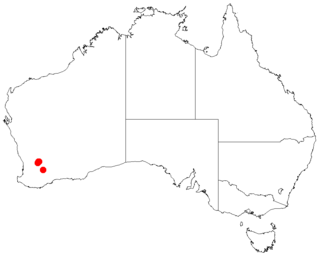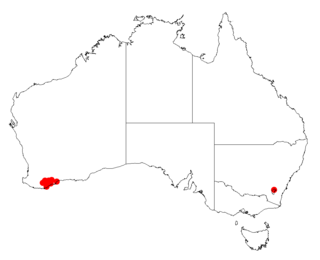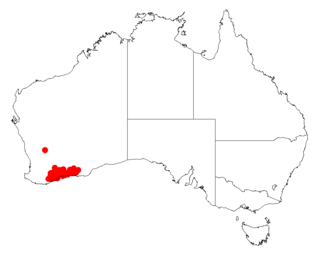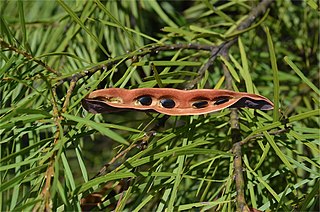
Acacia adenogonia is a shrub of the genus Acacia and the subgenus Plurinerves that is endemic to north western Australia.

Acacia aulacophylla is a shrub of the genus Acacia and the subgenus Plurinerves that is endemic to western Australia.

Acacia auratiflora, commonly known as the orange-flowered wattle, is a shrub of the genus Acacia and the subgenus Plurinerves. It is listed as an endangered species.

Acacia consobrina is a shrub of the genus Acacia and the subgenus Plurinerves that is endemic to south western Australia.

Acacia cowaniana, commonly known as Cowan's wattle, is a shrub or tree of the genus Acacia and the subgenus Plurinerves that is endemic to an area of south west Australia.

Acacia declinata is a shrub of the genus Acacia and the subgenus Plurinerves that is endemic to an area along the south coast in south western Australia.

Acacia donaldsonii is a shrub of the genus Acacia and the subgenus Plurinerves that is endemism in an area of south western Australia.

Acacia lanuginophylla, or woolly wattle, is a shrub of the genus Acacia and the subgenus Plurinerves that is endemic to south western Australia. It is currently listed as a vulnerable species according to the Environment Protection Biodiversity Conservation Act 1999.
Acacia manipularis is a shrub of the genus Acacia and the subgenus Plurinerves that is endemic to north western Australia.

Acacia obesa is a shrub of the genus Acacia and the subgenus Plurinerves that is native to a small area of south western Australia.

Acacia ophiolithica is a shrub of the genus Acacia and the subgenus Plurinerves where it is endemic to a small area along the south west coast of Australia.

Acacia patagiata, also commonly knowns as salt gully wattle, is a shrub of the genus Acacia and the subgenus Plurinerves that is endemic to south western Australia.

Acacia recurvata, commonly known as the recurved wattle, is a shrub of the genus Acacia and the subgenus Plurinerves that is endemic to a small area of western Australia.

Acacia sericophylla is a shrub or tree commonly known as the desert dogwood, desert oak or cork-bark wattle. To the Indigenous Australian people of the Pilbara, the Nyangumarta peoples, it is known as Pirrkala. The species is of the genus Acacia and the subgenus Plurinerves.

Acacia spongolitica is a shrub of the genus Acacia and the subgenus Plurinerves that is endemic to south western Australia.

Acacia undosa is a shrub of the genus Acacia and the subgenus Plurinerves that is endemic to an area of south western Australia.

Acacia wilsonii, also known as Wilson's wattle, is a shrub of the genus Acacia and the subgenus Plurinerves that is endemic to a small area of western Australia. It was listed as an endangered species in 2018 according to the Environment Protection and Biodiversity Conservation Act 1999 by Australian authorities and according to Biodiversity Conservation Act 2016 by Western Australian authorities.

Acacia cretacea, also known as chalky wattle, is a shrub belonging to the genus Acacia and the subgenus Phyllodineae that is endemic to South Australia.

Acacia latzii, also known as Latz's wattle and Tjilpi wattle, is a shrubby tree of the genus Acacia. It is native to the Finke bioregion.

Acacia macnuttiana, commonly known as McNutt's wattle, is a flowering plant in the family Fabaceae and is endemic to north-eastern New South Wales. It is a shrub with linear phyllodes, spherical heads of bright yellow flowers arranged in racemes in leaf axils and seeds usually in more or less straight, leathery pods.




















